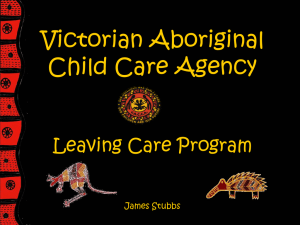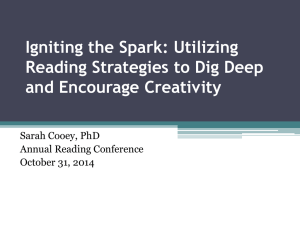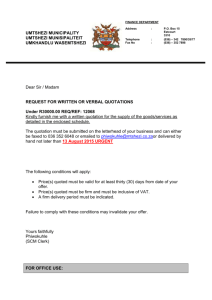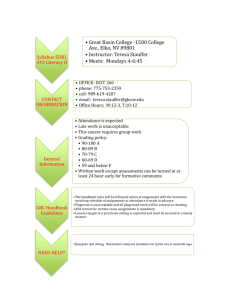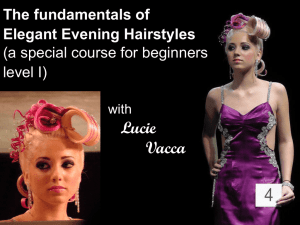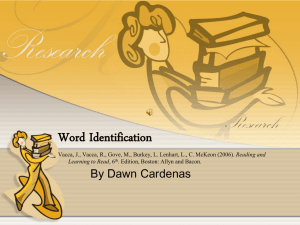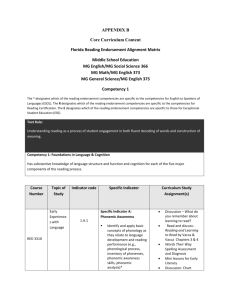Middle School Education
advertisement
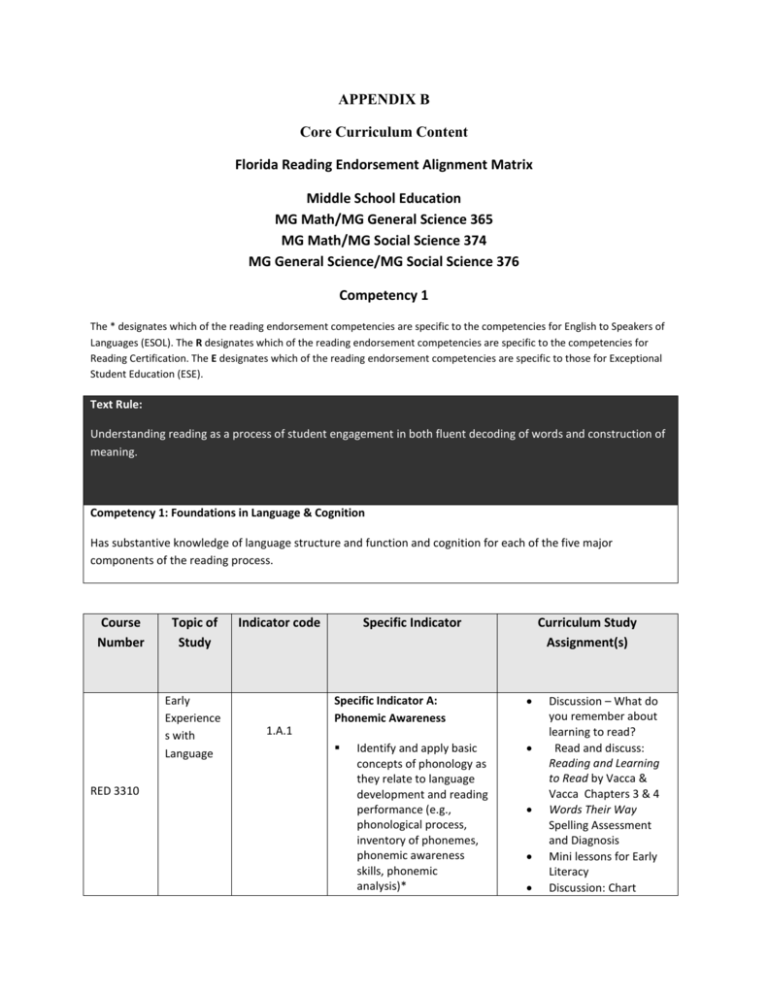
APPENDIX B Core Curriculum Content Florida Reading Endorsement Alignment Matrix Middle School Education MG Math/MG General Science 365 MG Math/MG Social Science 374 MG General Science/MG Social Science 376 Competency 1 The * designates which of the reading endorsement competencies are specific to the competencies for English to Speakers of Languages (ESOL). The R designates which of the reading endorsement competencies are specific to the competencies for Reading Certification. The E designates which of the reading endorsement competencies are specific to those for Exceptional Student Education (ESE). Text Rule: Understanding reading as a process of student engagement in both fluent decoding of words and construction of meaning. Competency 1: Foundations in Language & Cognition Has substantive knowledge of language structure and function and cognition for each of the five major components of the reading process. Course Number Topic of Study Early Experience s with Language RED 3310 Indicator code Curriculum Study Assignment(s) Specific Indicator Specific Indicator A: Phonemic Awareness 1.A.1 Identify and apply basic concepts of phonology as they relate to language development and reading performance (e.g., phonological process, inventory of phonemes, phonemic awareness skills, phonemic analysis)* Discussion – What do you remember about learning to read? Read and discuss: Reading and Learning to Read by Vacca & Vacca Chapters 3 & 4 Words Their Way Spelling Assessment and Diagnosis Mini lessons for Early Literacy Discussion: Chart stories, hands on activities, books appropriate for PK – 3, scaffolding instruction RED 3310 Early Experience s with 1.A.2 Language Big Book Activity - Read a big book to students making use of a "Oral Cloze" and modeling good reading behaviors. Distinguish both phonological and phonemic differences in language and their applications in written and oral discourse patterns (e.g., language & dialect differences)* - Describe the activity, student discovery and phonological and PA learning gains with this activity. Developing Reading RED 3310 1.B.1 Specific Indicator B: Phonics Proficiency RED 3310 Developing Reading Proficiency 1.B.2 Identify structural patterns of words as they relate to reading development and reading performance (e.g., inventory of orthographic representations, syllable conventions; spellings of prefixes, root words, affixes)* Apply structural analysis to words (e.g., orthographic analysis, spelling morphologies, advance phonics skills) RED 3310 Developing Reading Proficiency 1.C.1 Specific Indicator C: Fluency Identify the principles of reading fluency as they relate to reading development Review and summarize online storybooks Chapter 6 & 8 (Vacca & Vacca) Word Sorts Discussion: Include information concerning structural patterns, syllable conventions, prefixes, root words, and affixes- class discussion. Words Their Way spelling assessment and diagnosis Phonics Lesson Plan – mylabschool.com scenario Design a phonics lesson plan teaching a phonetic element through a song or chant (initial consonants, medial vowels, short vowels, or a morphemic feature). Mini lessons for word study Read and discuss : Chapter 7 (Vacca & Vacca) Discuss Rasinski article: http://www.prel.org/produ cts/re_/assessingfluency.htm Mini lessons for Fluency Readers Theatre Develop a fluency newsletter for parents RED 3310 RED 3310 Developing Reading Proficiency Vocabulary /Tools of Language 1.C.2 Understands the role of reading fluency in development of the reading process Specific Indicator D: Vocabulary 1.D.1 Identify and apply principles of English morphology as they relate to language acquisition (e.g., identify meanings of morphemes, inflectional and derivational morphemes, morphemic analysis) Fluency Activity. Develop fluency activity that showcases prosody, accuracy, and automaticity demonstrating the link between fluency and comprehension (suggested activities: Reader’s Theater; Choral Reading, Language Experience Activity, etc.) Read and discuss: Vacca & Vacca. Chapter 6: Vocabulary knowledge and concept development Mini lesson activities for Vocabulary Read and discuss activities from: - Teaching Vocabulary in all Classrooms by Camille Blachowicz and Peter Fisher - Words, Words, Words: Teaching Vocabulary in Grades 4 – 12 by Janet Allen RED 3310 Vocabulary /Tools of Language 1.D.2 Identify principles of semantics as they relate to vocabulary development (e.g., antonyms, synonyms, figurative language, etc.) RED 3310 Developing Reading Proficiency 1. E. 1 Specific Indicator E: Comprehension Identify principles of syntactic function as they relate to language acquisition and reading development (e.g., Mini lessons for Vocabulary Etymology - Latin and Greek origins Jeopardy game – Latin and Greek Hands on activities for vocabulary instruction (parts of speech, synonyms, antonyms, homophones, definitions) Introduction to dictionary and different formats for a thesaurus Lesson plan for vocabulary/comprehen sion mylabschool.com scenario Read and discuss Chapter 9 (Vacca & Vacca). Reading Comprehension Class presentations of phrase structure, types of sentences, sentence manipulations)* 1. E. 2 RED 3310 Developing Reading Proficiency 1. E. 3 RED 3310 Developing Reading Proficiency 1. E. 4 RED 3310 Developing Reading Proficiency Understands the impact of variations in written language of different text structures on the construction of meaning Identify cognitive task levels and the role of cognitive development in the construction of meaning of a variety of texts (e.g., knowledge, comprehension, application, analysis, synthesis, evaluation) Understands the transactive nature of the reading process in constructing meaning from a wide variety of texts and for a variety of purposes (e.g., text connections: within texts, across texts, from text to self, from text to world) Comprehension Strategy Mini lessons for content area and comprehension Introduce graphic organizers – online sites and books designed for educators Read and Discuss Text Structures Using the Vacca & Vacca textbook, provide descriptions (with page numbers) of chronological order, description, problem/solution, cause/effect, point of view, and compare/contrast formats. Read and discuss Chapter 11 (Vacca & Vacca): Meeting the literacy needs of diverse learners. Cinderella stories - Adapt for instruction - identify readability of text - synthesize text (using MS tool) and identify readability level - Modify text for LEP student and identify readability level. “But I say” strategy. Students use popular news item to debate: - Text to text (newspaper/print perspectives) - Text to Media (TV, WWW perspective) - Text to self (value perspective) RED 3310 Developing Reading Proficiency Developing Reading Proficiency Specific Indicator F: Integration of the major reading components 1.F.1 1.F.2 RED 3310 Identify language characteristics related to informal language and cognitive academic language.* Identify phonemic, semantic, and syntactic variability between English and other languages.* 1.F.3 RED 3310 Matching Reader and Text 1.F.4 RED 3310 Developing Reading Proficiency RED 3310 Developing Reading & Writing Proficiency 1.F.5 Understands the interdependence between each of the major reading components and their effect upon fluency in the reading process (e.g., reading rate: phonological processing and construction of meaning) Understands the interdependence between each of the major reading components and their affect upon comprehension (e.g., construction of meaning: vocabulary, fluency) Understands the impact of dialogue, writing to learn, and print environment upon reading development Five day plan for Basal or Core Book Read and discuss: Chapter 12 & 13 (Vacca & Vacca) Read and discuss: Chapter 10 (Vacca & Vacca): Meeting the Literacy needs of Diverse Learners Discuss strategies for ESOL students Context clues – different types of examples – discuss, small group project Differentiated Instruction model – discuss, small group project with fairy tales. Discussion: Elementary level scenario – classroom teacher reading lesson…positives and negatives of the lesson (comprehension or vocabulary lesson). Read and discuss: Chapter 15 (Vacca & Vacca) Read and discuss: Chapter 11 (Vacca & Vacca): Reading-Writing Connections. Describe the level of learning involved in using literacy (reading, writing, listening, thinking, and creating). Six Traits Writing Process Theme or Author unit – 10 hands on activities Florida Reading Endorsement Alignment Matrix Competency 2 Text Rule: Understanding reading as a process of student engagement in both fluent decoding of words and construction of meaning. COMPETENCY 2: Foundations of Research-Based Practices Understands the principles of scientifically based reading research as the foundation of comprehensive instruction that synchronizes and scaffolds each of the major components of the reading process toward student mastery. Course Number RED 3310 Topic of Study Indicator code Phonemic Awareness 2.A Specific Indicator Curriculum Study Assignment Specific Indicator A: Phonemic Awareness • Identify explicit, systematic instructional plans for scaffolding development of phonemic analysis of the sounds of words (e.g., phonemic blending, segmentation, etc.) * Phonics 2.B Specific Indicator B: Phonics • Identify explicit, systematic Read and discuss: Reading and Learning to Read (Vacca & Vacca) Chapter 6 Phonics lesson plan – mylabschool.com scenario Experiment using the Elkonin boxes with one, two, and three syllable words. Ask a child, adolescent, and/or adult to experiment with you. Explain the purpose of using techniques such as the Elkonin boxes. Word Sorts Introduction to Words Their Way (Bear, Invernizzi, Templeton & Johnson) Mini lessons for Word Study Etymology – Greek and Latin origins Jeopardy – Greek and Latin roots Words Their Way – Chapters & formats for instruction. RED 3310 Fluency 2.C instructional plans for scaffolding development from emergent through advanced phonics with words from both informal and academic language (e.g., orthographic skills, phonetic and structural analysis: rules, patterns, and generalizations) Word Sorts Develop a fluency newsletter for parents. Specific Indicator C: Fluency Read and discusss: Chapter 7 (Vacca & Vacca) Read and discuss: Rasinski article: RED 3310 • Identify explicit, systematic instructional plans for scaffolding fluency development and reading endurance (e.g., rereading, selftiming, independent reading material, reader’s theater, etc.) RED 3310 Strengtheni ng Vocabulary Developme nt 2.D Specific Indicator D: Vocabulary • Identify explicit, systematic instructional plans for scaffolding vocabulary and concept development (e.g., common morphological roots, morphemic analysis, system of word relationships, semantic mapping, semantic analysis, http://www.prel.org/products/re_/assessingfluency.htm Discuss different methods of Fluency assessment. Code passages for miscue analysis. Mini lessons for fluency Discuss this statement: Fluency is the bridge between vocabulary and comprehension. How does your instruction and data support this statement? Read and discuss: Chapter 8 (Vacca & Vacca) Discussion: Using the 3-2-1 Strategy, post your response to the following: 3 - List 3 concepts you learned about vocabulary 2 - List 2 instructional techniques you will use 1- Write 1 question you have about teaching vocabulary Mini lessons for vocabulary analogies, etc.) Comprehe nsion 2.E Specific Indicator E: Comprehension RED 3310 • Identify explicit, systematic instructional plans for scaffolding development of comprehension skills and cognition (e.g., key questioning strategies such as reciprocal teaching, analysis of relevance of details, prediction; “thinkaloud” strategies, sentence manipulation, paraphrasing, etc.) RED 3310 Instruction for Striving Readers 2.F.1 Specific Indicator F: Integration of the major reading components Read and discuss Chapter 9 (Vacca & Vacca) Introduce Webquests (Santa Rosa County site) Small group presentation: Comprehension strategies for small group and whole class instruction. Discuss use of graphic organizers for comprehension Mini lessons for comprehension Read and discuss: Chapters 6 & 8 (Vacca & Vacca) Create a Word Study or Vocabulary Lesson using specific strategies mylabschool.com scenario • Identify comprehensive instructional plans that synchronize the major reading components (e.g., a lesson plan: structural analysis, morphemic analysis, reciprocal teaching, rereading, etc.) RED 3310 Lesson 10: Teaching for Understan ding in the Content Areas 2.F.2 • Identify explicit, systematic instructional plan for scaffolding content area vocabulary development and reading skills (e.g., morphemic analysis, Cinderella stories - Adapt for instruction - identify readability of text - synthesize text (using MS tool) and identify readability level - Modify text for LEP student and identify readability level. semantic analysis, reciprocal teaching, writing to learn, etc.) RED 3310 RED 3310 Lesson 4: Language and PrintRich Environme nts Lesson 6: Bringing Students and Text Together Lesson 12: Instruction for Striving Readers 2.F.3 2.F.4 • Identify resources and research-based practices that create both language-rich and print-rich environments (e.g., large and diverse classroom libraries; questioning the author; interactive response to authentic reading and writing tasks, etc.) Mini lessons for comprehension and content area Read and discuss: Chapter 11 & 12 (Vacca & Vacca) Identify research-based guidelines and selection tools for choosing literature and expository text appropriate to students’ interests and independent reading proficiency R Discussion – What do you remember about learning to read? Read and discuss: Reading and Learning to Read by Vacca & Vacca Chapters 3 & 4 Words Their Way Spelling Assessment and Diagnosis Mini lessons for Early Literacy Discussion: Chart stories, hands on activities, books appropriate for PK – 3, scaffolding instruction Read and discuss chapter 9 and 14 (Vacca & Vacca) Mini lessons for content, comprehension and literature Read and discuss text structures. Using the Vacca & Vacca textbook, provide descriptions (with page numbers) of chronological order, description, problem/solution, cause/effect, point of view, and compare/contrast formats. “But I Say” Strategy Readability measures Select 2 children books or young adult novels and conduct the following readability measures on each of the books. Fry Readability - Conduct a read ability of the texts using the Fry Readability method. - Identify the readability level of the book. FLIP - Is the book Friendly? - Does the book have appropriate Language? - Is the book true to its Intent? - Does the student have Prior Knowledge concerning the topic? Cinderella Stories - Adapt for instruction - identify readability of text - synthesize text (using MS tool) and identify readability level - Modify text for LEP student and identify readability level. Students use popular news item or short story to debate: - Text to text (newspaper/print perspectives) - Text to Media (TV, WWW perspective) - Text to self (value perspective)
